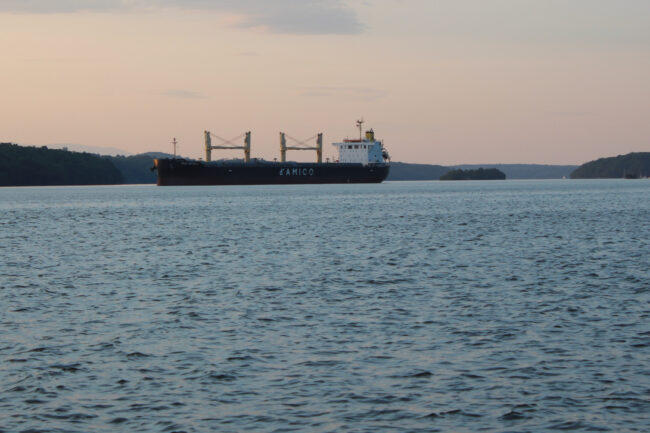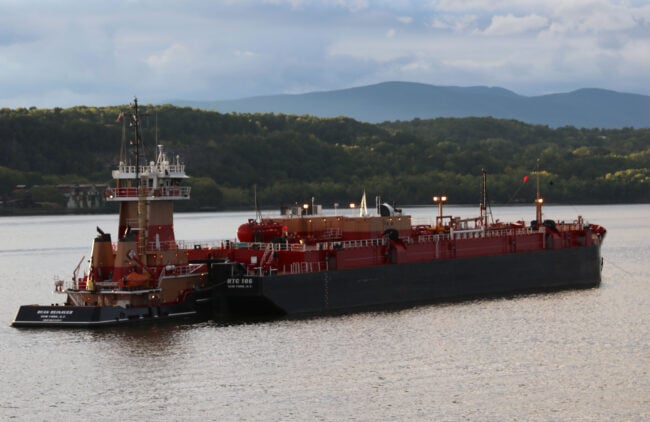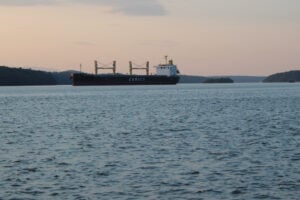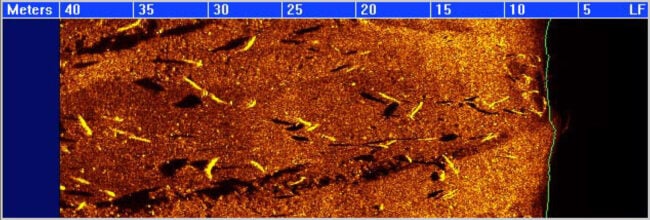Hudson River anchorages: It’s time to stand up for the river again

A ship at anchor at Hyde Park
View more images on our Flickr site

Oil barge at Kingston (Photo by Carolyn Marks Blackwood)
[NOTE: VISIT THIS PAGE TO READ OUR UPDATE, NOVEMBER 12, 2023: Riverkeeper celebrates reversal of U.S. Coast Guard Policy on Hudson River Anchoring]
Recent Coast Guard bulletin unlawfully allows vessels to anchor virtually anywhere north of the Governor Mario M. Cuomo Bridge; Riverkeeper takes steps to protect aquatic life, critical habitat areas, and Hudson River drinking water supplies
In 2016, communities throughout the Hudson Valley united in opposition to a maritime industry request to vastly expand the designated areas in the Hudson River where commercial vessels are allowed to anchor.
Riverkeeper and the public made clear that we want strict limits on where, and for how long, commercial vessels are allowed to anchor in the Hudson River. Potential spills of hazardous cargo and threats to endangered sturgeon were among the top concerns. At the time, the tug and barge industry was eyeing a surge in crude oil shipments from the Midwest. The public outcry was huge: The Coast Guard received an unprecedented 10,212 comments, overwhelmingly opposed to the tug and barge industry’s request for 43 new berths in 10 locations along the river. In addition, dozens of local resolutions and numerous letters came from state, county and municipal governments, objecting to the proposal.
The industry’s request went nowhere, and so anchorage grounds – formally-designated anchoring locations – north of the Cuomo Bridge continued to be limited to just one location off Hyde Park.
Now, in 2023, all of that is changing.
What the Coast Guard is saying
The Coast Guard has reviewed the basis for regulations governing anchoring in the Hudson River. That review has resulted in significant changes:
- The Coast Guard issued an information bulletin (MSIB 2023-001) on July 25, 2023 which suddenly redefined the Port of New York to only include the Hudson River as far north as the Cuomo Bridge at Tarrytown, instead of the Port of Albany.
- The area north of the Cuomo Bridge is now outside the port, and is now subject to the Coast Guard’s “Inland Navigation Rules.” Under these rules, any vessel may anchor virtually anywhere for any duration, providing they do not interfere with traffic and have the required nighttime lighting.
What this means
As a result of these changes, the Hudson River’s ecosystem, endangered species, and drinking water sources are again at risk, because there are virtually no restrictions right now on when, where or for how long large commercial vessels can anchor in the Hudson River north of the Cuomo Bridge. The entire river north of the Cuomo Bridge to Kingston is effectively available for anchoring. The maritime industry does not have to petition for a formal anchorage ground designation in that stretch of the river anymore.
How can this be legal?
Riverkeeper contends that the Coast Guard bulletin was issued unlawfully, without the necessary environmental studies. There are a host of significant environmental impacts that may result from the revised geographic scope of the “Port of New York,” all of which must be fully evaluated under the law. Of great concern is the fact that the Coast Guard redefined the “Port of New York” without addressing the more than 10,000 comments and concerns raised in 2016 by the public, local, county, and state elected officials; New York State agencies and departments; and environmental organizations. Such comments highlighted environmental and public safety concerns related to the 10 new anchoring ground locations. By issuing a bulletin to redefine the boundaries of the “Port of New York”, the Coast Guard has attempted to circumvent the public rulemaking process to permit anchoring well beyond the ten additional locations proposed in the 2016 rulemaking.
In a letter sent to the Coast Guard September 19, 2023, Riverkeeper outlines multiple reasons why the bulletin is unlawful, and asks that the boundaries of the Port of New York be restored until the required environmental reviews are conducted and regulations are in place to protect the Hudson.

A ship at anchor at Hyde Park
“The concerns are the same now as they were in 2016,” Riverkeeper notes in its letter. “New anchorage locations affect waterfront tourism, present hazards to public safety and boating, pose new and unmitigated spill risks, increase industrialization of the Hudson Valley, cause noise and light pollution, damage existing and future submerged electric transmission cables, and damage or destroy benthic [bottom] habitat relied upon by federally endangered sturgeon.”
In addition, the relaxation of anchoring restrictions north of the Cuomo Bridge will allow an increased number of commercial vessels carrying a variety of hazardous cargoes to anchor on the Hudson River thereby increasing the risk of a catastrophic spill and potential for damage to the drinking water source of the seven communities within the Hudson River Drinking Water Intermunicipal Council, Riverkeeper’s letter states. A serious spill could render hundreds of thousands of people without clean water.
What the public has said
The Coast Guard’s recent action flies in the face of laws, regulations, and municipal resolutions passed over the last seven years to restrict anchorage grounds in the Hudson. The clear message from the public was that large commercial vessels should be restricted to a few locations in the Hudson River estuary, because of a range of risks.
Elected officials up and down the Hudson echoed the concerns put forth by Riverkeeper and members of the public in 2016. In addition, the New York State Department of State submitted comments together with the state Department of Environmental Conservation, Department of Public Service and Office of Parks, Recreation and Historic Preservation regarding the U.S. Coast Guard’s consideration of new anchorage grounds in the Hudson River from Yonkers, NY to Kingston, NY. “After examining the limited information presented by the U.S. Coast Guard, the Agencies do not believe that adopting the proposal … is an acceptable solution,” the agencies wrote.
Section 8437 of the Elijah E. Cummings Coast Guard Authorization Act of 2020 suspended the establishment of new anchorage grounds between Yonkers and Kingston. The Coast Guard’s recent redefinition of the Port of New York effectively establishes an unlimited number of new anchorage areas north of the Cuomo Bridge, and therefore essentially circumvents the intent and the restrictions set forth in the act.
Protecting drinking water
Seven communities draw their drinking water from the mid-Hudson: the Town of Esopus, Town of Hyde Park, Town of Lloyd, Town and City of Poughkeepsie, Town and Village of Rhinebeck. Collectively known as the Hudson River Drinking Water Intermunicipal Council, or Hudson 7, these communities have two concerns that could become the basis of a petition to the Coast Guard to establish regulated navigation areas (RNAs) where certain anchoring activities can be restricted or prohibited.
One of these concerns is the possibility of an anchored vessel physically striking an intake pipe on the bottom of the river.
Another is the concern over anchored vessels containing potentially hazardous material, such as diesel fuel, heating oil, asphalt, or other cargo. Spilled petroleum products or other contaminants could reach the drinking water intakes of the Hudson 7 communities if anchoring is not restricted near all water intake areas. Any contaminant could move north and south with the tides, daily. A serious spill could leave seven communities without clean drinking water.
Protecting sturgeon
Hyde Park – Anchorage Ground 19A
The area where these drinking water intakes are located is also an area essential to the survival of the Hudson’s two species of sturgeon, both of which are critically endangered: Atlantic sturgeon, which spawn in the Hudson and spend most of their lives in the ocean; and shortnose sturgeon, which live mostly in the Hudson itself.
The area off Hyde Park is thought to be the largest remaining concentration of spawning Atlantic sturgeon on the eastern seaboard. But here are the sobering facts. Historically, it’s estimated that the total number of Hudson River spawning age Atlantic sturgeon was once 6,000 females and 8,000 males. The most recent population estimate developed for one year, 2014, put the total at 466, male and female, in the Hudson.

An image using side-scan sonar of Atlantic sturgeon congregating near the anchorage at Hyde Park (John A. Madsen / University of Delaware Department of Geological Sciences and Dewayne Fox / Delaware State University)
The Hyde Park area is the location of an existing designated anchorage ground known as 19A. An accident at this location could threaten the future existence of Atlantic sturgeon in the Hudson. The very presence of large anchored vessels here damages sturgeon spawning and foraging habitat. Researchers, using side-scan sonar, captured images of sturgeon here (photo, above). Images also showed scarring of the river bottom caused by anchors and chains (photo, below). When an anchor drags, large areas of river bottom are damaged. The rate of repair of the damage is unknown.

Scientists using side-scan sonar have documented anchor “scarring” of benthic (bottom) habitat used by federally endangered sturgeon in the Hudson
(John A. Madsen / University of Delaware Department of Geological Sciences and Dewayne Fox / Delaware State University)
The Kingston Hub
About 6 miles north of Hyde Park, between the drinking water intakes at Rhinebeck and Esopus, is an area known to mariners as the “Kingston hub.”
Shortnose sturgeon spend the winter there, and researchers have identified it as ultra-critical habitat for them.
The New York State Department of Environmental Conservation, or others, could petition for an RNA off Hyde Park, or at the Kingston hub, to help protect these habitats. An RNA at either or both of these locations could restrict when, or even if, any anchoring by large vessel should be allowed there.
What Riverkeeper is doing
Riverkeeper shares the goals of the Hudson 7 to protect its drinking water source for 100,000 people, and of the DEC to protect both species of endangered sturgeon in the Hudson. We are working closely with the Hudson 7 communities as they consider drafting an RNA petition. We are also in consultation with the DEC as they investigate options to protect sturgeon. As needed, Riverkeeper may submit an RNA petition of its own for the protection of the river.
At the same time, Riverkeeper has alerted the Coast Guard that its recent bulletin redefining the Port of New York is unlawful and unenforceable. Riverkeeper urges the Coast Guard to immediately issue a new bulletin to reestablish the geographic scope of the Port of New York to include all areas of the Hudson as far north as the Port of Albany, and once again restrict the anchoring of large commercial vessels to existing designated anchorages and conduct all the required studies and procedures before further changes are made.
What you can do now
Please share this post with your neighbors and elected officials. Watch for updates at Riverkeeper’s campaign page: Riverkeeper.org/anchorages.
At this time, there is no formal process to submit comments to the Coast Guard about its recent actions. However, be assured that Riverkeeper is working to develop ways to make your concerns known to the Coast Guard and your elected officials.
Stay informed and find out about actions you can take by signing up to receive Riverkeeper emails.
